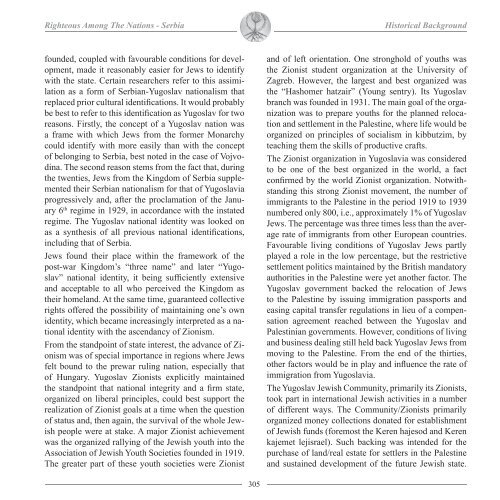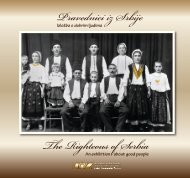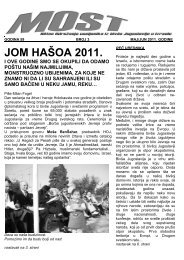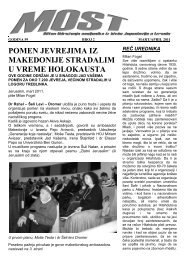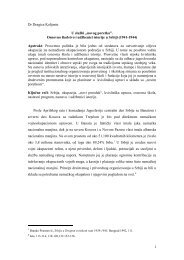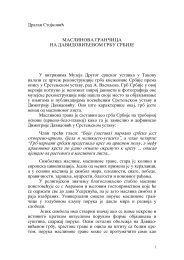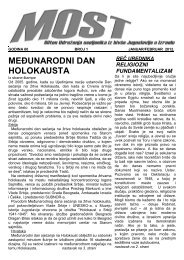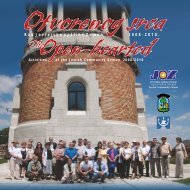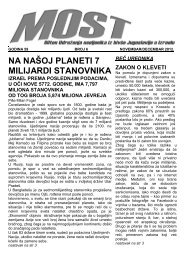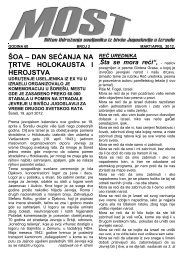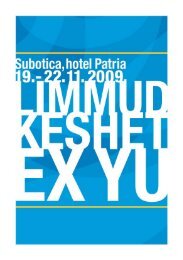Book on the Righteous - Jevrejska opština Zemun
Book on the Righteous - Jevrejska opština Zemun
Book on the Righteous - Jevrejska opština Zemun
Create successful ePaper yourself
Turn your PDF publications into a flip-book with our unique Google optimized e-Paper software.
<strong>Righteous</strong> Am<strong>on</strong>g The Nati<strong>on</strong>s - Serbia<br />
Historical Background<br />
founded, coupled with favourable c<strong>on</strong>diti<strong>on</strong>s for development,<br />
made it reas<strong>on</strong>ably easier for Jews to identify<br />
with <strong>the</strong> state. Certain researchers refer to this assimilati<strong>on</strong><br />
as a form of Serbian-Yugoslav nati<strong>on</strong>alism that<br />
replaced prior cultural identificati<strong>on</strong>s. It would probably<br />
be best to refer to this identificati<strong>on</strong> as Yugoslav for two<br />
reas<strong>on</strong>s. Firstly, <strong>the</strong> c<strong>on</strong>cept of a Yugoslav nati<strong>on</strong> was<br />
a frame with which Jews from <strong>the</strong> former M<strong>on</strong>archy<br />
could identify with more easily than with <strong>the</strong> c<strong>on</strong>cept<br />
of bel<strong>on</strong>ging to Serbia, best noted in <strong>the</strong> case of Vojvodina.<br />
The sec<strong>on</strong>d reas<strong>on</strong> stems from <strong>the</strong> fact that, during<br />
<strong>the</strong> twenties, Jews from <strong>the</strong> Kingdom of Serbia supplemented<br />
<strong>the</strong>ir Serbian nati<strong>on</strong>alism for that of Yugoslavia<br />
progressively and, after <strong>the</strong> proclamati<strong>on</strong> of <strong>the</strong> January<br />
6 th regime in 1929, in accordance with <strong>the</strong> instated<br />
regime. The Yugoslav nati<strong>on</strong>al identity was looked <strong>on</strong><br />
as a syn<strong>the</strong>sis of all previous nati<strong>on</strong>al identificati<strong>on</strong>s,<br />
including that of Serbia.<br />
Jews found <strong>the</strong>ir place within <strong>the</strong> framework of <strong>the</strong><br />
post-war Kingdom’s “three name” and later “Yugoslav”<br />
nati<strong>on</strong>al identity, it being sufficiently extensive<br />
and acceptable to all who perceived <strong>the</strong> Kingdom as<br />
<strong>the</strong>ir homeland. At <strong>the</strong> same time, guaranteed collective<br />
rights offered <strong>the</strong> possibility of maintaining <strong>on</strong>e’s own<br />
identity, which became increasingly interpreted as a nati<strong>on</strong>al<br />
identity with <strong>the</strong> ascendancy of Zi<strong>on</strong>ism.<br />
From <strong>the</strong> standpoint of state interest, <strong>the</strong> advance of Zi<strong>on</strong>ism<br />
was of special importance in regi<strong>on</strong>s where Jews<br />
felt bound to <strong>the</strong> prewar ruling nati<strong>on</strong>, especially that<br />
of Hungary. Yugoslav Zi<strong>on</strong>ists explicitly maintained<br />
<strong>the</strong> standpoint that nati<strong>on</strong>al integrity and a firm state,<br />
organized <strong>on</strong> liberal principles, could best support <strong>the</strong><br />
realizati<strong>on</strong> of Zi<strong>on</strong>ist goals at a time when <strong>the</strong> questi<strong>on</strong><br />
of status and, <strong>the</strong>n again, <strong>the</strong> survival of <strong>the</strong> whole Jewish<br />
people were at stake. A major Zi<strong>on</strong>ist achievement<br />
was <strong>the</strong> organized rallying of <strong>the</strong> Jewish youth into <strong>the</strong><br />
Associati<strong>on</strong> of Jewish Youth Societies founded in 1919.<br />
The greater part of <strong>the</strong>se youth societies were Zi<strong>on</strong>ist<br />
and of left orientati<strong>on</strong>. One str<strong>on</strong>ghold of youths was<br />
<strong>the</strong> Zi<strong>on</strong>ist student organizati<strong>on</strong> at <strong>the</strong> University of<br />
Zagreb. However, <strong>the</strong> largest and best organized was<br />
<strong>the</strong> “Hashomer hatzair” (Young sentry). Its Yugoslav<br />
branch was founded in 1931. The main goal of <strong>the</strong> organizati<strong>on</strong><br />
was to prepare youths for <strong>the</strong> planned relocati<strong>on</strong><br />
and settlement in <strong>the</strong> Palestine, where life would be<br />
organized <strong>on</strong> principles of socialism in kibbutzim, by<br />
teaching <strong>the</strong>m <strong>the</strong> skills of productive crafts.<br />
The Zi<strong>on</strong>ist organizati<strong>on</strong> in Yugoslavia was c<strong>on</strong>sidered<br />
to be <strong>on</strong>e of <strong>the</strong> best organized in <strong>the</strong> world, a fact<br />
c<strong>on</strong>firmed by <strong>the</strong> world Zi<strong>on</strong>ist organizati<strong>on</strong>. Notwithstanding<br />
this str<strong>on</strong>g Zi<strong>on</strong>ist movement, <strong>the</strong> number of<br />
immigrants to <strong>the</strong> Palestine in <strong>the</strong> period 1919 to 1939<br />
numbered <strong>on</strong>ly 800, i.e., approximately 1% of Yugoslav<br />
Jews. The percentage was three times less than <strong>the</strong> average<br />
rate of immigrants from o<strong>the</strong>r European countries.<br />
Favourable living c<strong>on</strong>diti<strong>on</strong>s of Yugoslav Jews partly<br />
played a role in <strong>the</strong> low percentage, but <strong>the</strong> restrictive<br />
settlement politics maintained by <strong>the</strong> British mandatory<br />
authorities in <strong>the</strong> Palestine were yet ano<strong>the</strong>r factor. The<br />
Yugoslav government backed <strong>the</strong> relocati<strong>on</strong> of Jews<br />
to <strong>the</strong> Palestine by issuing immigrati<strong>on</strong> passports and<br />
easing capital transfer regulati<strong>on</strong>s in lieu of a compensati<strong>on</strong><br />
agreement reached between <strong>the</strong> Yugoslav and<br />
Palestinian governments. However, c<strong>on</strong>diti<strong>on</strong>s of living<br />
and business dealing still held back Yugoslav Jews from<br />
moving to <strong>the</strong> Palestine. From <strong>the</strong> end of <strong>the</strong> thirties,<br />
o<strong>the</strong>r factors would be in play and influence <strong>the</strong> rate of<br />
immigrati<strong>on</strong> from Yugoslavia.<br />
The Yugoslav Jewish Community, primarily its Zi<strong>on</strong>ists,<br />
took part in internati<strong>on</strong>al Jewish activities in a number<br />
of different ways. The Community/Zi<strong>on</strong>ists primarily<br />
organized m<strong>on</strong>ey collecti<strong>on</strong>s d<strong>on</strong>ated for establishment<br />
of Jewish funds (foremost <strong>the</strong> Keren hajesod and Keren<br />
kajemet lejisrael). Such backing was intended for <strong>the</strong><br />
purchase of land/real estate for settlers in <strong>the</strong> Palestine<br />
and sustained development of <strong>the</strong> future Jewish state.<br />
305


